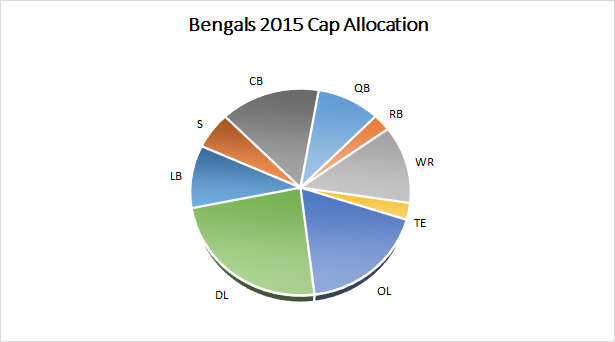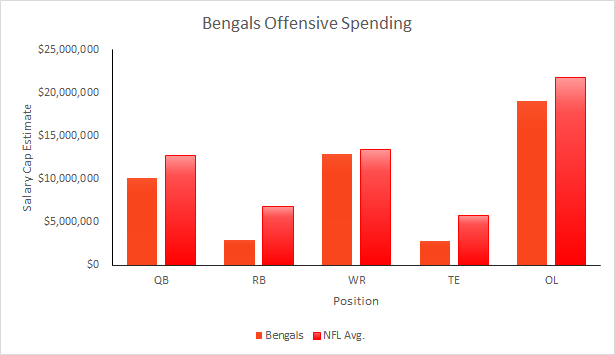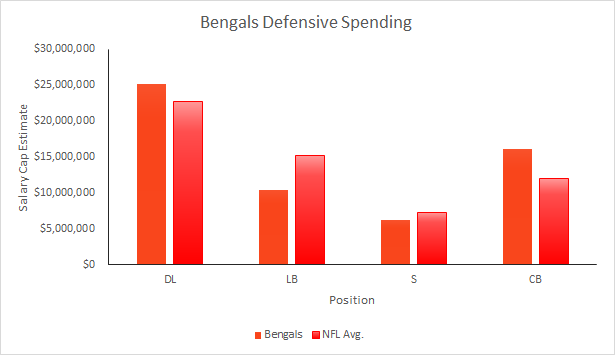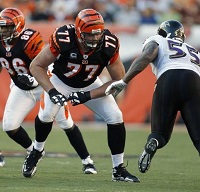Estimated 2015 Cap Space: $32.8M ($140M cap limit)
Roster Overview
Players Under Contract: 57
Pro Bowlers: 2
Unrestricted Free Agents: 13(4 with 50%+ playtime)
Draft Selection: 21
Salary Cap Breakdown


Free Agents to Re-sign
If the team is looking for stability in their running game and pass protection it would seem clear that Clint Boling would be brought back. The question will be if he wants to test free agency and see what’s there or take a deal with Cincy now. Testing free agency can be a risk for him if nobody bites but it’s also a risk for Cincy to let him get there in the event he finds a big contract that the Bengals won’t match…The only avenue to upgrade over Ray Maualuga is through the draft so he will probably return on low cost contract. There is limited upside but he knows the system and the coaching staff is comfortable with him so for a reasonable salary he is worth keeping…I would expect the team to keep both Mike Nugent and Eric Winston next year. Nether will cost much.
Free Agents to Let Walk
The Bengals have not been able to get the maximum potential out of Jermaine Gresham and even if they wanted him back I doubt he would want to come back. His best contract strategy is to find a job with a team that utilizes the position and hope that springboards him to a big contract in 2016…Neither Dane Sanzenbacher nor Brandon Tate contribute offensively to really care about either way as both are replaceable. Tate does have some value with returns, but not enough to make a real effort to keep.
Contracts to Modify
The Bengals should approach AJ Green about a contract extension to see if they can get something worked out. Green has put up incredible numbers prior to his injury filled 2014 season and is arguably the best receiver in the NFL. The Bengals have not had to negotiate a contract of this magnitude since the days of Carson Palmer and this may be their best chance to get something done on their terms. If they let things play out and begin the franchise tag process it will just hurt long term.
Players to Consider Releasing
The Bengals will likely have three release candidates in Domata Peko, Robert Geathers, and Wallace Gilberry. That said none make much money and none should be cut until replacements are found either in free agency or the draft.
Offseason Plan
The Bengals are the first playoff team we’ve covered and by far look to have the most uneventful offseason ahead, which is why the above sections were so short compared to the other teams. They don’t really have any major contract headaches nor any big time free agents. While they do have a large surplus of cap room I don’t think anyone expects them to go on a wild spending spree in free agency. If they want to take that quick step forward they may need to do some things they have not been comfortable with in the past, though that may not be in the long term interests of the team.
I see this offseason focused more on bringing more youth onto the defensive side of the ball and preparing for a somewhat large roster turnover in 2016. Seven big defensive contributors (T. Newman, Geathers, A. Jones, R. Nelson, Gilberry, L. Hall, and Peko) are all at least 30 years of age and clearly the defensive side needs those young players to take over the defense sooner rather than later.
Cincinnati is very value conscious and they will likely look for low cost free agents with upside to help fill in some gaps while focusing on the draft for the bigger production. I don’t think you would connect the Bengals with any Tier 1 or probably Tier 2 free agents, but more likely find them sorting through the bargain bin of the Adrian Clayborn’s of the world where they think they can might uncover a low cost starter, specifically at one of the end positions.
Even if the team doesn’t keep Gresham it would not seem that offense will be their focus. They have a terrific backfield and Green is an all world talent at receiver. Andy Dalton is streaky as a quarterback, but at this point the team is resigned to what he is. Hopefully he can grow into something more, but adding more receivers isn’t going to make the difference.
I would anticipate the draft will put a strong emphasis on defense. The team desperately needs to improve the pass rush and upgrade their defensive end position. They need more youth in the secondary and may need more players at linebacker. The team should have enough left in the tank to compete again for a playoff spot, but unless they have a good draft this is probably going to mark the end of their consistent playoff run.
Bengals Links
Bengals Salary Cap Pages
Bengals Free Agents
Bengals Contracts
Bengals GM Salary Cap Calculator
Other Offseason Salary Cap Reports
Bengals Free Agent Simulator




